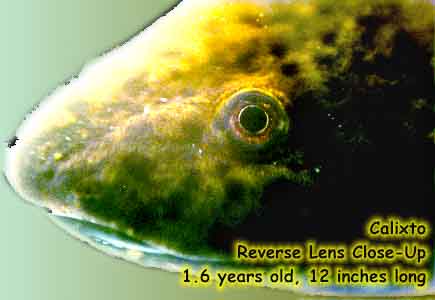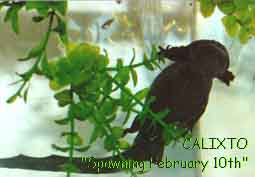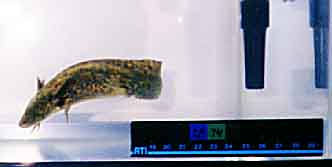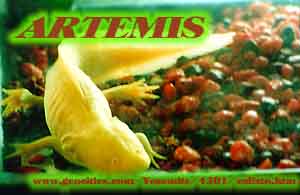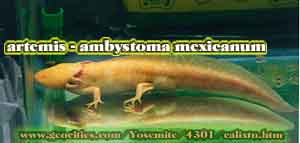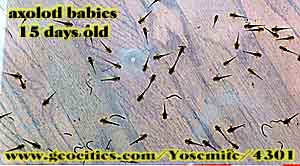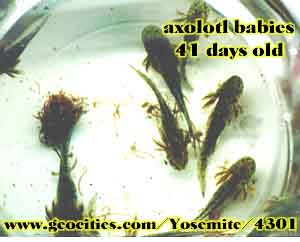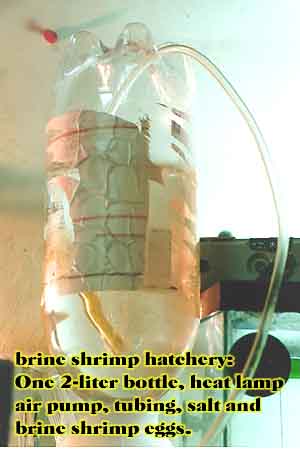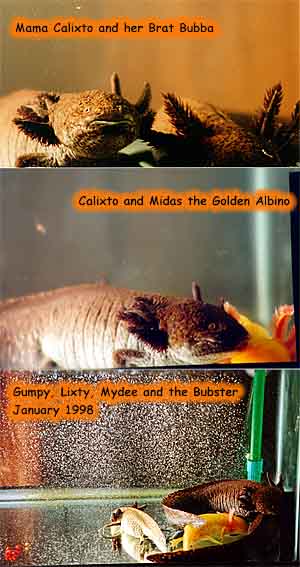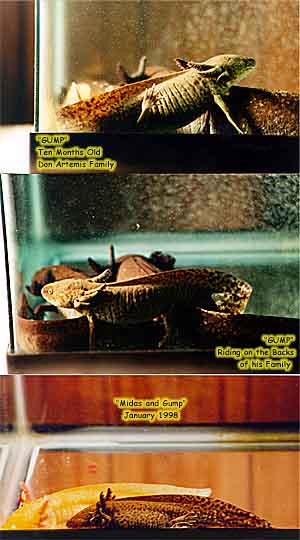index
[Calixto][Description]
[Axolotl FAQ]

[My Axolotls]
[Habitat]
[Feeding]
[Health]
[References]
[Links]
[Genetics]
contact
axolotls@yahoo.com-or-
Sign
The
Guestbook
version
98.12.02visits
travel
Da Homepagelegal
© 1996-1998Chris Eng
All Rights
Reserved

My First Axolotls
My interest in axolotls began with Calixto, a female wild-type axolotl, spawned New Years 1996. Artemis is a male golden albino axolotl, age unknown. He was purchased at Bangkok Aquarium in San José, California, three weeks before Calixto's was put into my trust. Although Artemis was 3 times larger than Calixto at that time, they are about the same size now.The Beginning
Calixto is more rotund, due to her voracious appetite and somatotype, and Artemis is thinner has a much longer tail section, he eats much less than Calixto. Both were kept in separate 10 gallon tanks with Eheim 2213 and Fluval 103 filters. I had a third axolotl who was a golden albino, but Calixto had that one as a late night snack.Courtship
On Jan 18th 97, Calixto left his tank to join Artemis. For the first few hours, Artemis cloaca was open and he was dancing around Calixto wiggling his body and tail section. Calixto was animate, but basically largely ignored him. From this point on continuing for the next few weeks, it was unknown whether Calixto was a male or female. Axolotls are difficult to sex until they mature, around one year of age. Over the weeks, Calixto and Artemis did not exhibit any sexual activity, but nonetheless seemed to enjoy each others company.Settling Down
On February 9th 1997, I did a complete water change and refreshed the Eheim 2213 with new media. I also added enough river rocks to cover the bottom of the tank. In addition, I tore the base off three small plastics plants. This allowed the plants to float on top of the water column. I did this to provide cover for the axolotls and guppies.The First Spawn
The following day, Calixto was moving around on top of the plants with the top of her head out of the water. At first, it was thought that she was just playing around. Upon further inspection, she was gripping the leaves and stems of the plants with her legs and depositing eggs, surrounded by jelly sacs, on them. Unlike other urodoles and amphibians, axolotl embryos require lots of oxygen and therefore the eggs are not layed in mass clumps. They are spread about on plants and smooth surfaces, like river rocks. Oddly enough, Calixto preferred to wrestle with the plants and deposit her eggs on them, as opposed to depositing them on the easy to access and available rocks. Approximately 800 eggs were deposited on the plants and a negligible amount were deposited on the rocks.Axolotl Eggs
The next day, I transferred the rocks and plants with the eggs on it to an aerated 12 gallon crate. The first batch of eggs, over 200, hatched on February 24th with the remainder hatching the next day. The total survival rate was about 97% or 766 hatchlings. As of August 3rd, the larvae are at the beginning stage of growing arms.Two Months in the Life of the First Spawn
The First 60 Days Page Size=85KBrine Shrimp Cocktail
The hatchlings were fed newly hatched brine shrimp Artemia daily on February 26th, since they have already digested their yolk sacs and their mouths are fully developed. Within minutes their bellies were orange. I decided to explore other methods of feeding. A reasonable alternative was to experiment with cut-up tubifex worms. The larvae survived sans brine shrimp and managed to eat the scissor-cut worms, even though the worms were about as long as the larvae and about as thick as the axolotls mouth! Axolotls will try to eat anything put in front of their face.Color Types
The babies, from all three spawns, are all wild-types and albino recessive. See Axolotl Genetics for a detailed discussion on the inheritance of color, phenotypes, in axolotls, and what percentage of albinos, whites, and golden-albinos that I will get from backcrossing Artemis with one of the spawn.Another Spawn?
On February 17th, 17 days after her first spawn, Calixto spawned again! Ideally, spawning should not be repeated for three to four months. I am not sure if this is unusual or not. Ideally, females be spawned at three to four month intervals.The Second Round
The Second batch of eggs started to hatch on March 3rd. However, the more amazing thing that happened was that Calixto spawned again for the third time on March 12th, the same day as the second hatch. As of March 13th, she was finally transported back to her original tank, and resumed spawning there. She is going to lay about 100 eggs this time.The Third Spawn?!?!
Most of the third spawn was infertile, which is not surprising since Calixto is a young mother and spawned three times within a month. The third batch should hatch on March 27th. I have only kept a select few from the first spawn to raise and give up for adoption. The legs of the first spawn are starting to develop today, (March 26th.Housing the Babies
I have put the remaining 13 babies in different aquaria and different filtration, including none, to see how it affects their development. So far, the largest axolotls have come from being in a community, partitioned 10 gallon aquarium with high filtration and a dense network of plant cover, as opposed to the ones individually housed. This is contrary to many published papers on axolotl husbandary. The ones individually kept in styrofoam half-height cups, using filtered water with changes done every four days, developed slower than the ones in the community.My New Axolotls
From the first spawn, I have only kept two of them. I chose Bubba, the largest (by far) of the first spawn and Margartia, who had his tail nipped by Bubba when they were about a month old. At 80 days old, Bubba is five inches long, his sibling Margarita is about 40% smaller in size.Current News - June 1997
June 4th - Artemis, Bubba and Margarita are now sharing the same tank. The cannibalism stage has passed, and they seem very happy in each others company. At 99 days old, Bubba is 7 inches long(!!) and Margarita is 4½ inches long. In comparison, Artemis is 10 inches long and Calixto is 11 inches long.On June 14th, Margarita was adopted, and separated from Artemis and Bubba, who were sharing the same tank. Artemis developed cottony patches on his skin. It does not seem to communicable, since Margarita and Bubba over the past 72 hours did not develop any symptoms. More discussion on what happened on the Axolotl Health Page
June 20th, Bubba is now hanging with Calixto.
Artemis and Chong Die
July '97, Unfortunately the fungus infection that Artemis had was not completely eliminated. It was dormant and reinfected Artemis, who later died. Subsequently, it was dormant on Margarita who had shared a tank with Chong (Margarita spend time with Artemis). Margarita infected Chong, who later died. Bubba, who shared the same tank with Artemis and Margarita during the time of the initial infection was not infected. Calixto, who shared the same tank with Bubba, also was not infected.What Was It?
As, far as we can tell, it was a gram-positive infection, not a gram-negative, which I misdiagnosed early on. The initial Mercurochrome® and Salt Batch Treatment helped the initial infection. Artemis was left alone for a week, and the lack of immediate care made it to late to save him. Margarita was treated with Marycn® and MarOxy®, and survived.